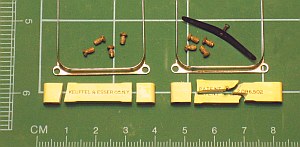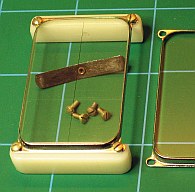previous <<==>> next
KEUFFEL & ESSER 4083-3 ( 10" / 25 cm Scales )
MouseOver Cursor for Details

KEUFFEL & ESSER, New York / USA SN = 098614 (1940)
************************************************************************
S C A L E S of the » H Y P E R L O G DUPLEX « Model 4083-3
========================================================================
Front Side [ inverse / RED ] Back Side
========================================================================
L lgX [LL0] [exp(-0.001X) .. exp(-0.01X) .. exp(-0.1X)]
LL1 exp(0.01X) [LL00] [exp(-0.1X) .. exp(-1X) .. exp(-10X)]
DF πX A X2
------------------------------------------------------------------------
CF πX B X2
[CIF] [1/πX] T tan(0.1X) ; [cot(0.1X)]
[CI] [1/X] ST arc(0.01X)
C X S sin(0.1X) ; [cos(0.1X)]
------------------------------------------------------------------------
D X D X
LL3 exp(X) Th TanH(0.1X) <0.1 .. 3>
LL2 exp(0.1X) Sh2 SinH(X) <0.85 .. 3>
Sh1 SinH(0.1X) <0.1 .. 0.9>
R E M A R K S :
========================================================================
[LL0] & [LL00] are keyed to A ( !!! ) ; LL1, LL2 & LL3 are keyed to D
The DEFINITIVE FORMS for the HYPERBOLIC FUNCTIONS are:
CosH(X) = ( exp(+X) + exp(-X) ) / 2 <== this is the "Chain Line"
SinH(X) = ( exp(+X) - exp(-X) ) / 2 ( eg. suspension bridge )
TanH(X) = SinH(X) / CosH(X)
exp(X) = SinH(X) + CosH(X)
1 = CosH2(X) - SinH2(X)
Using the Hyperbolic Functions:
Start with value on the Sh scales ==>> reading SinH on D scale,
start with value on the D scale ==>> reading ArcSinH on Sh.
Start with value on the Th scale ==>> reading TanH on D scale,
start with value on the D scale ==>> reading ArcTanH on Th.
The scales are identical to DIETZGEN-1735 ...
The SR came in a brown plastic case with missing flap. This model is
made of mahogany with scales on celluloid veneer. The CURSOR-BLOCKS,
made of CELLULOID where detoriated ...
|

 ... and had to be replaced by home-made PVC ones.
Same "CELLULOID DISEASE" happened also (e.g.) to the
... and had to be replaced by home-made PVC ones.
Same "CELLULOID DISEASE" happened also (e.g.) to the